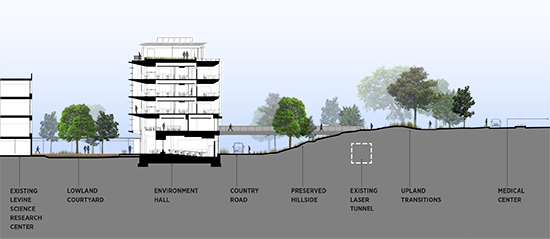Recognizing years of campus expansion and sprawl, the site for Duke University’s new Environment Hall was chosen specifically to help “re-densify” the campus fabric in order to both minimize the project’s environmental footprint and to define a series of pedestrian-scaled exterior spaces along an important pathway connecting the University’s historic main campus to its state-of-the-art medical campus. Located in the Sciences Precinct, the site is bounded by existing campus buildings along its east, south and west edges and mitigates a central loading dock to the southwest and an abruptly sloped hillside to the north creating, a 1-story change in grade.
The site is comprised of a set of interwoven sequential landscapes which ground the new building and link the existing science precinct to the expanding medical center. The landscapes include:
LOWLAND COURTYARD uses low-impact design principles including elevated pedestrian platforms floating above a protected bio-retention area used to clean roof run-off from existing buildings.
GARDEN ROOF inspired by the soil and topography displaced by the new building and comprised of all edible plantings. The garden roof helps reduce site stormwater run-off and serves as a mirrored pair of informal outdoor classrooms.
COUNTRY ROAD replaces an existing asphalt parking lot with native, adapted low maintenance plants while still allowing pedestrian, bicycle and service vehicle access across the site.
PRESERVED HILLSIDE existing vegetation was leveraged to reduce the potential for erosion during construction, after which, all invasive plants were removed and replaced with native species.
UPLAND TRANSITION landscape which converted an existing parking lot to a new pedestrian campus space serving as a forecourt to the new building. Disjointed tree canopies on either side of the site were reconnected and existing soils rehabilitated to aid in stormwater infiltration and significantly reduce run-off.

Garden roof and solar PV trellis

Pedestrian walks float above a bio-retention landscape



